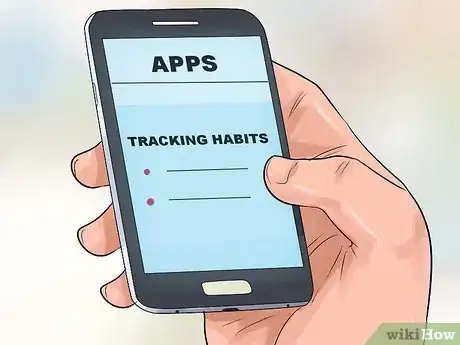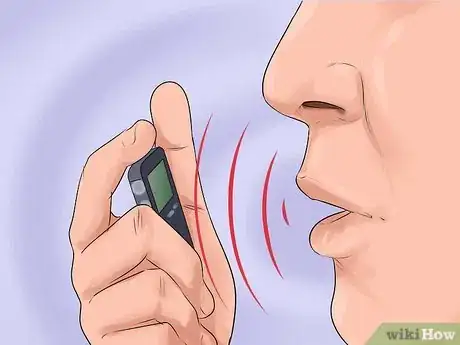This article was co-authored by Klare Heston, LCSW. Klare Heston is a Licensed Independent Clinical Social Worker based in Cleveland, Ohio. With experience in academic counseling and clinical supervision, Klare received her Master of Social Work from the Virginia Commonwealth University in 1983. She also holds a 2-Year Post-Graduate Certificate from the Gestalt Institute of Cleveland, as well as certification in Family Therapy, Supervision, Mediation, and Trauma Recovery and Treatment (EMDR).
There are 7 references cited in this article, which can be found at the bottom of the page.
This article has been viewed 27,887 times.
You might have a range of goals in mind when setting out to observe yourself. Fortunately, there are plenty of ways to go about it. Get in touch with your authentic self through meditation and self-reflection. Keep a journal to learn more about how you interact with the world and how those interactions shape who you are. Learn a new ability or improve your job performance by observing yourself on video. Whether you’re practicing meditation, keeping a journal, or watching video recordings, remember to focus on progress. If you observe something you want to change, think about how you can improve instead of just focusing on a flaw.
Steps
Becoming Self Aware
-
1Consider who you’ve become and what defines you. Over the course of our lives, we go acquire deeper levels of psychological awareness. During adolescence, we form our identities and our self-image becomes more robust. Spend time reflecting on what you’ve become, what values you hold most dear, and what your defining traits are.
- Ask yourself, “What sets me apart from others? What characteristics make up my essence? What are some key life experiences that have made me who I am?”
- Examples of traits and values could include humor, honesty, or loyalty. A skill like singing or an athletic ability could be an important part of who you are.
- Remember to be open to more than just positive attributes. When you’re reflecting on who you are, be open to things about yourself that might not be the best qualities. For example, you might ask yourself, “How is my laziness or temper a part of me? How do these attributes fit into my overall being, and what do I desire to change about myself?”
-
2Reflect on the differences between your ideal self and actual self. Think about how you represent yourself to others, especially as you consider the attributes that make you proud and those you’d like to change.
- Ask yourself, “What are the differences between how I represent myself to others and how I perceive myself? Do I let others define me too much? How can I integrate, or unify, the ideal self that I show others and the actual self I try to keep to myself?”
- Look for the differences by questioning how you think about yourself versus how you act in person. For example, "Do I tend to present myself as flawed by constantly joking about my awkwardness or how I look?" or "Do I mislead people about what I do in my free time because I'm embarrassed about my real life?"
Advertisement -
3Keep a journal to track your journey of self-awareness. Psychologists agree that self-awareness is a dynamic, changing process. We shift between degrees of self-awareness, self-deception, and everything in between. [1] Try keeping a daily journal and write a daily self-reflection to keep a record of your journey.
- Write down a few details about your day, how you interacted with others, and recall your reactions and feelings about the day’s various happenings. You might write, for example, "Today I ran into James and we ended up having a disagreement. He said something that I thought was an underhanded way of insulting me, so I called him on it immediately. It escalated, and we ended the conversation on really bad terms."
- Choose a regular time, whether every couple weeks or once a month, to read your past entries. You might read back an entry and think or write in response, "After a couple weeks' distance, I've realized that James probably wasn't trying to offend me. Reading my entry back, I realize I probably jumped to conclusions. Observing this conversation with a little distance has given me the motivation to try to smooth things over with James."
- Try not to feel embarrassment or self-judgment when you read things you wrote, but try to be open to learning about yourself. Observe yourself taking shape with each experience. Open yourself up to being aware of how you react to various situations, how your feelings respond to interactions, and how those responses in turn shape you into the person you are.
Observing Yourself Through Meditation
-
1Prepare to meditate. Find a quiet place to meditate that’s free of noise and other distractions. Designate a time that you can dedicate to meditation without thinking of other tasks or necessities.
- Sit comfortably on a cushion or chair. Play soothing music or white noise sounds if it helps you free your mind. Close your eyes or leave them open, depending on whichever better helps you focus.
- Control your breathing by counting to four as you breath inward, holding for a count of two, then counting to four again as you exhale.
-
2Ponder your blind spots. As you put yourself in a meditative state, try to open your mind to objectively consider your blind spots. Visualize your actions and thoughts as if you were a detached observer. Open yourself to self truths you might be keeping yourself from discovering.[2]
- Ask yourself, “Do I have any unrealistic expectations of myself, or of my thoughts and actions?” As you breath, visualize your self-expectations melted away with each breath.
- As each layer of expectations melt away, imagine the self truths left behind with each passing layer of your self-representations. Ask, “What thoughts, values, and experiences are left behind as I peel away the various ways that I show myself to the world?”
-
3Become your own inner witness. Focus on an individual thought, emotion, or action. Try letting your mind wander, and as your mind generates random thoughts, follow them rather than react to them. Observe your own stream of consciousness as if you were an outsider looking within your mind, then guide yourself back to your silent meditation.[3]
- Ask, “What is this thought or series of thoughts, and why does my mind conjure it? What does it mean that my mind drifts into this stream of consciousness?"
-
4Consider using a guided meditation app. You might think you need to switch off your mobile device in order to meditate. However, there are several excellent mobile meditation apps available for both Android and iOS that can help guide you to a peaceful, reflective state.[4]
- The Mindfulness App, Headspace, and Calm are easy to use and have free services with additional options for per track purchases or monthly subscriptions.
- The app Smiling Mind is completely free and offers tracks divided by age group, making it a great option for children, teens, and adults.
- If you want to avoid using your mobile device or don't have one, you can also search Youtube for guided meditations that encourage mindfulness and self-reflection.
Observing Yourself in Action
-
1Use self observation to learn new skills. There's evidence that observing yourself on video as you learn a new motor skill provides motivation, better execution of the skill, and helps you remember how to do the skill. Further, self observation using video benefits both children and adults. [5]
- Consider using a cell phone or other video recorder to observe yourself. It can help you have an easier time learning a new routine in dance class, footwork for a sport, or other physical act of coordination.
-
2Record yourself doing your job. In addition to learning new activities, you can use self observation to improve your job performance. For example, it's been shown that observing video of themselves at work had positive effects on teachers' professional development.[6]
- Similarly, evidence suggests that video recording helps nurses and student nurses master clinical skills and improve patient interactions.[7]
- Filming yourself works by taking you out of the situation and letting you observe. You'll be able to notice more as an observer, which can help you overcome the tendency to self-criticize.
- Since cell phones and computers with built-in webcams have made video recording so universal, you can easily apply these findings to your own life. Record yourself doing your job to promote your own professional development. If you have to make a speech or presentation, record yourself and look for parts of your public speaking performance that need a little work.
-
3Focus on progress when practicing self observation. Successes and failures are central to self observation, whether you’re practicing meditation, keeping a journal, or recording yourself giving a presentation. Cognitive behaviorists and psychologists agree that focusing on accomplishments when observing or monitoring yourself generates more accomplishments.
- In other words, recognizing your progress motivates you to keep succeeding. Emphasizing failures decreases motivation and lowers the chances of future progress.
- Stay positive when practicing self observation and focus on how you can improve yourself instead of things you don’t like! When observing your own flaws and failures, look for potential causes and changes you can make instead of just getting discouraged.
- For example, you might read a past journal entry and think, “Gosh, I really overreacted and lost my temper for no reason,” or you might have noticed in a video recording that you kept missing a step in a dance routine. Try not to focus on what you did wrong, but think of ways you can improve your temper or nail that dance step.
Expert Q&A
-
QuestionWhat does self-observation mean?
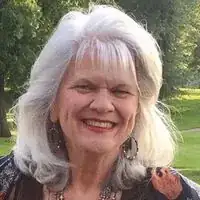 Klare Heston, LCSWKlare Heston is a Licensed Independent Clinical Social Worker based in Cleveland, Ohio. With experience in academic counseling and clinical supervision, Klare received her Master of Social Work from the Virginia Commonwealth University in 1983. She also holds a 2-Year Post-Graduate Certificate from the Gestalt Institute of Cleveland, as well as certification in Family Therapy, Supervision, Mediation, and Trauma Recovery and Treatment (EMDR).
Klare Heston, LCSWKlare Heston is a Licensed Independent Clinical Social Worker based in Cleveland, Ohio. With experience in academic counseling and clinical supervision, Klare received her Master of Social Work from the Virginia Commonwealth University in 1983. She also holds a 2-Year Post-Graduate Certificate from the Gestalt Institute of Cleveland, as well as certification in Family Therapy, Supervision, Mediation, and Trauma Recovery and Treatment (EMDR).
Licensed Social Worker It means paying attention to yourself from the outside like another observer. It involves an element of detachment and objectivity. You can take notes, listen to others' feedback, videotape yourself, or write in a journal.
It means paying attention to yourself from the outside like another observer. It involves an element of detachment and objectivity. You can take notes, listen to others' feedback, videotape yourself, or write in a journal. -
QuestionWhat is self-observation in psychology?
 Klare Heston, LCSWKlare Heston is a Licensed Independent Clinical Social Worker based in Cleveland, Ohio. With experience in academic counseling and clinical supervision, Klare received her Master of Social Work from the Virginia Commonwealth University in 1983. She also holds a 2-Year Post-Graduate Certificate from the Gestalt Institute of Cleveland, as well as certification in Family Therapy, Supervision, Mediation, and Trauma Recovery and Treatment (EMDR).
Klare Heston, LCSWKlare Heston is a Licensed Independent Clinical Social Worker based in Cleveland, Ohio. With experience in academic counseling and clinical supervision, Klare received her Master of Social Work from the Virginia Commonwealth University in 1983. She also holds a 2-Year Post-Graduate Certificate from the Gestalt Institute of Cleveland, as well as certification in Family Therapy, Supervision, Mediation, and Trauma Recovery and Treatment (EMDR).
Licensed Social Worker It is tuning into the self and trying to gain greater understanding through observation and reporting that out.
It is tuning into the self and trying to gain greater understanding through observation and reporting that out. -
QuestionHow did Wilhelm Wundt's method of self-observation work?
 Klare Heston, LCSWKlare Heston is a Licensed Independent Clinical Social Worker based in Cleveland, Ohio. With experience in academic counseling and clinical supervision, Klare received her Master of Social Work from the Virginia Commonwealth University in 1983. She also holds a 2-Year Post-Graduate Certificate from the Gestalt Institute of Cleveland, as well as certification in Family Therapy, Supervision, Mediation, and Trauma Recovery and Treatment (EMDR).
Klare Heston, LCSWKlare Heston is a Licensed Independent Clinical Social Worker based in Cleveland, Ohio. With experience in academic counseling and clinical supervision, Klare received her Master of Social Work from the Virginia Commonwealth University in 1983. She also holds a 2-Year Post-Graduate Certificate from the Gestalt Institute of Cleveland, as well as certification in Family Therapy, Supervision, Mediation, and Trauma Recovery and Treatment (EMDR).
Licensed Social Worker He believed that the attentive observation of mental processes (perception) can be made as they occur and that those processes are not distorted by the observation.
He believed that the attentive observation of mental processes (perception) can be made as they occur and that those processes are not distorted by the observation.
References
- ↑ http://www.psychology.emory.edu/cognition/rochat/Rochat5levels.pdf
- ↑ http://www.huffingtonpost.com/devi-sawh/intro-to-meditation----the-challenge-of-self-observation_b_9957746.html
- ↑ https://yogainternational.com/article/view/become-your-own-inner-witness
- ↑ https://www.theguardian.com/technology/2016/may/26/five-of-the-best-meditation-apps
- ↑ https://www.ncbi.nlm.nih.gov/pmc/articles/PMC3554505/
- ↑ http://files.eric.ed.gov/fulltext/EJ1055171.pdf
- ↑ http://file.scirp.org/Html/1-1440180_40504.htm


-Step-6.webp)
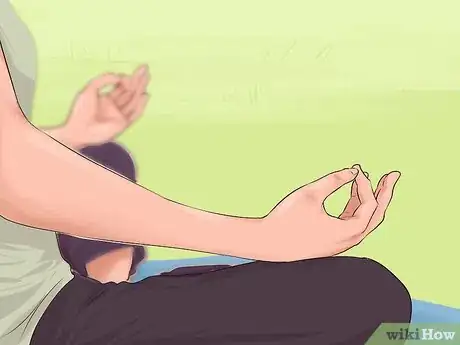
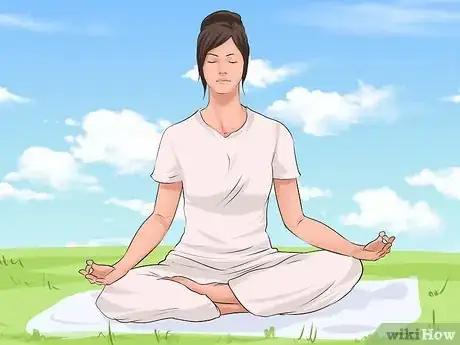
-Step-11.webp)
